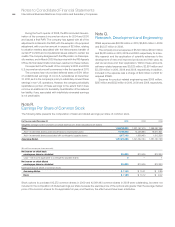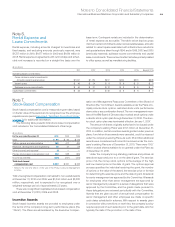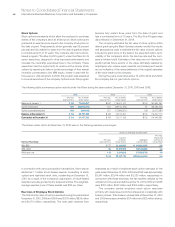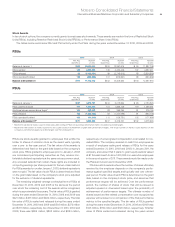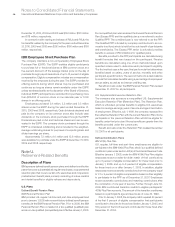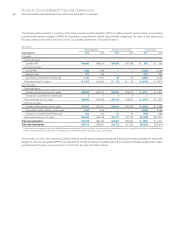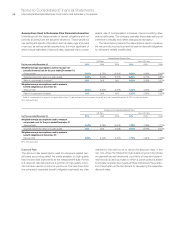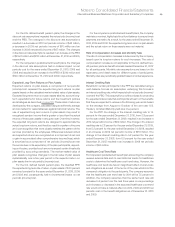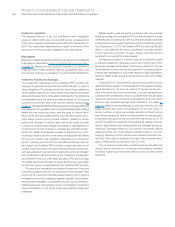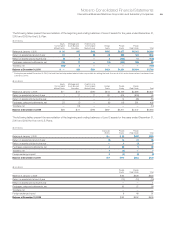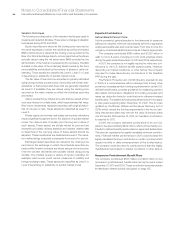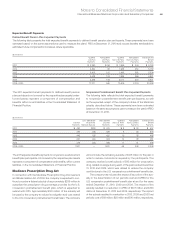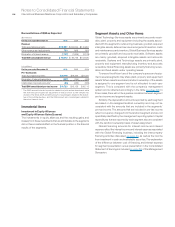IBM 2010 Annual Report Download - page 120
Download and view the complete annual report
Please find page 120 of the 2010 IBM annual report below. You can navigate through the pages in the report by either clicking on the pages listed below, or by using the keyword search tool below to find specific information within the annual report.
Notes to Consolidated Financial Statements
International Business Machines Corporation and Subsidiary Companies118
Defined Benefit Pension Plans
U.S. Plans Non-U.S. Plans
For the year ended December 31: 2010 2009 2008 2010 2009 2008
Weighted-average assumptions used to measure net
periodic (income)/cost for the year ended December 31:
Discount rate 5.60% 5.75% 6.00% 4.84% 4.89% 5.06%
Expected long-term returns on plan assets 8.00% 8.00% 8.00% 6.56% 6.73% 6.86%
Rate of compensation increase* N/A N/A N/A 2.92% 3.09% 3.23%
Weighted-average assumptions used to measure
benefit obligations at December 31:
Discount rate 5.00% 5.60% 5.75% 4.33% 4.84% 4.89%
Rate of compensation increase* N/A N/A N/A 2.37% 2.92% 3.09%
* Rate of compensation increase is not applicable to the U.S. defined benefit pension plans as benefit accruals ceased December 31, 2007 for all participants.
N/A—Not applicable
Nonpension Postretirement Benefit Plans
U.S. Plan Non-U.S. Plans
For the year ended December 31: 2010 2009 2008 2010 2009 2008
Weighted-average assumptions used to measure
net periodic cost for the year ended December 31:
Discount rate 5.40% 5.75% 6.00% 7.92% 7.36% 7.13%
Expected long-term returns on plan assets N/A N/A 3.02% 9.16% 9.19% 9.04%
Weighted-average assumptions used to measure
benefit obligations at December 31:
Discount rate 4.80% 5.40% 5.75% 7.75% 7.92% 7.36%
N/A—Not applicable
Assumptions Used to Determine Plan Financial Information
Underlying both the measurement of benefit obligations and net
periodic (income)/cost are actuarial valuations. These valuations
use participant-specific information such as salary, age and years
of service, as well as certain assumptions, the most significant of
which include estimates of discount rates, expected return on plan
Discount Rate
The discount rate assumptions used for retirement-related ben-
efit plans accounting reflect the yields available on high-quality,
fixed income debt instruments at the measurement date. For the
U.S. discount rate assumptions, a portfolio of high-quality corpo-
rate bonds is used to construct a yield curve. The cash flows from
the company’s expected benefit obligation payments are then
assets, rate of compensation increases, interest crediting rates
and mortality rates. The company evaluates these assumptions, at
a minimum, annually, and makes changes as necessary.
The table below presents the assumptions used to measure
the net periodic (income)/cost and the year-end benefit obligations
for retirement-related benefit plans.
matched to the yield curve to derive the discount rates. In the
non-U.S., where the markets for high-quality long-term bonds are
not generally as well developed, a portfolio of long-term govern-
ment bonds is used as a base, to which a credit spread is added
to simulate corporate bond yields at these maturities in the jurisdic-
tion of each plan, as the benchmark for developing the respective
discount rates.


